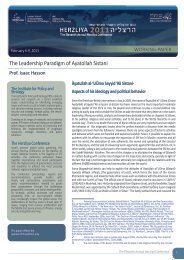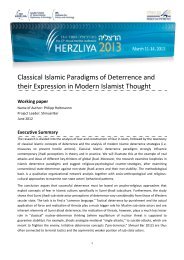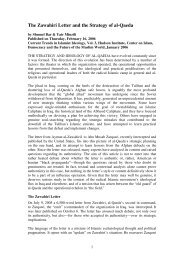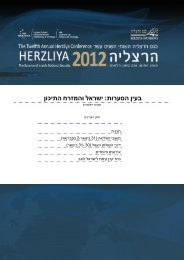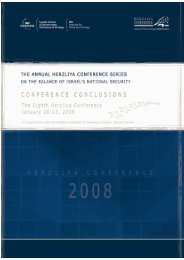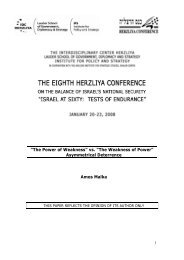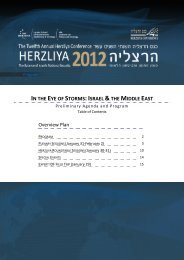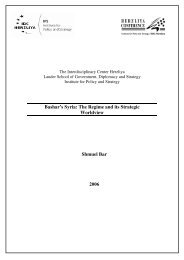Iran: Cultural Values, Self images and Negotiation Behavior
Iran: Cultural Values, Self images and Negotiation Behavior
Iran: Cultural Values, Self images and Negotiation Behavior
You also want an ePaper? Increase the reach of your titles
YUMPU automatically turns print PDFs into web optimized ePapers that Google loves.
<strong>Iran</strong>: <strong>Cultural</strong> <strong>Values</strong>, <strong>Self</strong>-<strong>images</strong> <strong>and</strong> Negotiating <strong>Behavior</strong>accepted among the religiously conservative <strong>Iran</strong>ian peasantry. The internal migrationof peasants to the large cities created an urban peasant class with peasant-style socialideology in an urban setting. 88 This utopian messianic belief has its transient add-on,as expressed by the famous vizier, Nezam al-Mulk: it is the sins of the people whichcauses God to corrupt the ruler, thus encouraging “drawing of many swords” <strong>and</strong>chaos, which purges the l<strong>and</strong> of sinners (<strong>and</strong> innocents) <strong>and</strong> then brings forward byGod’s Grace (farr-e izadi) a new just ruler (padeshah-e dad-gostar), who “puts an endto chaos <strong>and</strong> anarchy, spreads his fear… so that people will feel safe” (my emphasis.SB). 89 The farr-e Izadi is a manifest phenomenon; it is discernable on the ruler whohas it. While it is a necessary condition for legitimacy as a ruler, it is not a sufficientcondition for continued acceptance of his sway; this is contingent on his being a “justruler”, <strong>and</strong>, since <strong>Iran</strong>ian traditions of royalty put little emphasis – if any – onprimogeniture as a source of legitimacy, this condition is even more dem<strong>and</strong>ing forthe next in line after the founder of a dynasty. 90These religious <strong>and</strong> psycho-sociological etiologies, however, do not explain themanifest willingness of <strong>Iran</strong>ians to accept despotic regimes as the result of revolutionsagainst such regimes. According to another interpretation, the phenomenon is onlyostensibly popular, but is actually elitist. It takes place only at the top of a traditional<strong>Iran</strong>ian tri-functional pyramid (composed of a temporal <strong>and</strong> religious leadership, thecoercive forces of the military, <strong>and</strong> the economic forces of the nation), with theacquiescence of the other levels of the pyramid. According to this viewpoint, the 1905constitutional revolution, the coronation of Reza Shah in 1925 <strong>and</strong> his abdication <strong>and</strong>replacement by his son in 1941, the overthrow of the Mossadegh government <strong>and</strong> thereturn of the Shah in 1953, <strong>and</strong> finally the Islamic revolution, are all “palacerevolutions”, the results of which are accepted by the masses. 91 The legitimacy forthese frequent revolutions is provided, according to this theory, by <strong>Iran</strong>ian nationalmythology, which recounts the heroism of popular saviors, who dethrone oppressiverulers only to become despots themselves. This mythology, it is claimed, serves as the“fabric of <strong>Iran</strong>ians’ collective unconscious” <strong>and</strong> the source of a collective “repetitioncompulsion” which forces <strong>Iran</strong> to repeat the cycles of the nation’s mythical <strong>and</strong>historic past. 92 Attribution of modern political ideas to ancient myths should,however, be tempered by a caveat as the same myth can be interpreted with different<strong>and</strong> even diametrically opposed implications for modern times. During most of thehistory of Shiite Islam the occultation of the Imam was perceived as a convincingargument for political quietism; the 20 th century Ayatollahs ‘Ali Shari’ati <strong>and</strong>Rohallah Khomeini interpreted the very same tenet of faith as obliging politicalactivism, each of them reaching different conclusions regarding the form <strong>and</strong> goals ofthis activism. 93The common denominator of all the above attempts to decipher the code ofrevolutionarism in <strong>Iran</strong>ian society is that <strong>Iran</strong> has through the ages been a “short termsociety” caught in a cyclical pattern of arbitrary <strong>and</strong> despotic rule: socialuncertainty→growing discontent→chaos→willingness to accept any new regime in88 Dorraj 168-170.89 Katouzian 22–26.90 Homa Katouzian. “Legitimacy <strong>and</strong> Succession in <strong>Iran</strong>ian History,” Comparative Studies of SouthAsia, Africa <strong>and</strong> the Middle East 23.18 2003: 236–240.91 Hoveyda 54–55.92 Fereydoun Hoveyda, <strong>Iran</strong>ian Mythology <strong>and</strong> Islamic Revolution, Praeger, London, pp. 60–64.93 Dorraj. 5.22



